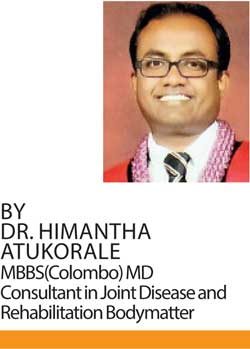06 Oct 2017 - {{hitsCtrl.values.hits}}

A very painful shoulder with lots of stiffness and inability to lift the arm above the head might be due to a condition called frozen shoulder. The more complicated medical term given for this is “adhesive capsulitis “ but this name is not used often. There are many reasons for frozen shoulder and also various treatment options available.
People between the ages of approximately 40-60 might be affected and yes it affects more women than men. There are a few underlying conditions that might cause a frozen shoulder. Here are a few facts about frozen shoulder that might tweak your interests.
Many patients think that this condition affects the bones of the shoulder. Which is a myth. The shoulder joint with its bones are healthy and unaffected. The condition affects a covering outside the shoulder joint called the joint capsule. Usually this capsule/cover protects the joint from various outer impacts.

Imagine a rubber hose with all the ability to bend in any direction. The elasticity of the rubber hose allows all sorts of movements. But if some external factor reduces the elasticity, the hose would end up as a rigid structure.
Similarly the elastic rubbery nature of the joint capsule needs to be preserved in order for the shoulder joint to move in any direction. If this is lost, the shoulder will become painful and stiff. In some cases both shoulders are affected.
Fixing a Frozen Shoulder Underlying Conditions
Diabetes, especially uncontrolled sugar level is a key reason that predispose the patients to frozen shoulder/ adhesive capsulitis. Thyroid gland problems, trauma to the shoulder region are a few
other reasons.
So how do patients present? There are a few phases any person undergoes. Initially patients complain of severe pain especially when moving away the arm from the body, and try to lift it over the head. Then later they have pain and stiffness both. Stiffness prevents them from lifting the arm even if they can withstand the pain. The arm feels stuck / frozen at the shoulder level. Movements like scratching the back of chest or touching the back of head are difficult or impossible. The third phase is when pain disappears and stiffness remains. The forth and the final phase is when everything returns to normal. However not all patients experience
these phases.
Other than frozen shoulder there are many conditions that could mimic the symptoms. Shoulder joint inflammation/swelling because of conditions like rheumatoid arthritis can cause pain and stiffness. The stiffness is worse in the mornings and gets better as the day progresses. There are conditions called sub-acromial bursitis and supraspinatus tendinitis. Again lifting the shoulder in these diseases can cause pain. Problems with the neck/ upper part of spine can cause referred shoulder pain.
Osteoarthritis can present with shoulder pain too. There is pain and stiffness after prolonged periods of rest. In osteoarthritis patients have features of wear and tear of other joints such as the knees.
Ultimately the shoulder is involved in most of the things that we do. Imagine eating, brushing your hair, shaving, washing the face or even reaching out for a cup. All these movements require the shoulder. This is the reason why frozen shoulder causes so much agony among the patients.
Prevention and Treatment
So what are the solutions? First of all, the underlying condition/ cause should be properly treated. If I put it in a simple way, when the consultants prescribe treatment to a patient, there are certain things that we expect back from the patient himself. In badly controlled diabetes, proper blood sugar levels achieved through medication, diet and exercise is vital. It is the same when it comes to thyroid gland problems.
Pain relief is achieved through non steroid anti-inflammatory agents(NSAIDS). These are not just painkillers like paracetamol or morphine. They somewhat modify the joint structure so that patients regain some independence in mobility. Your consultant will decide whether the NSAIDS are suitable or not. A certain category of patients require NSAIDS for several weeks to reap
the benefits.
Steroids like prednisolone and methylprednisolone are tried as well. Steroids have side effects like escalating the blood sugar levels in a diabetic patient, weight gain etc.. But if the benefits outweigh the disadvantages, a short course of these tablets are very useful. Steroids are given in the form of an injection as well, which is a very effective intervention.
Shoulder joint mobilisation is a must for all who have frozen shoulder. In fact, that is one of the few steps we try initially in any patient who presents to a hospital in United Kingdom. Mobilisation is done through extremely simple exercises which can be practiced at home. The diagrams of how to do exercises are provided and the patient is given
specific instructions.
If the muscles are very stiff, certain tablets which relieve muscle spasm are used for a short duration. Prolonged pain causes muscles to contract, and the tired muscles release lactic acid. This acid in turn further aggravate pain and this goes on as a vicious cycle. In order to break the cycle, we give muscle relaxants.
Usually the above methods are bound to work but occasionally if stiffness persists, we refer the patient to the orthopaedic surgeons. For frozen shoulder there are several excellent surgical solutions like manipulation under anaesthesia, arthroscopic capsular release and hydrodilatation.
23 Dec 2024 2 hours ago
23 Dec 2024 3 hours ago
23 Dec 2024 3 hours ago
23 Dec 2024 4 hours ago
23 Dec 2024 5 hours ago